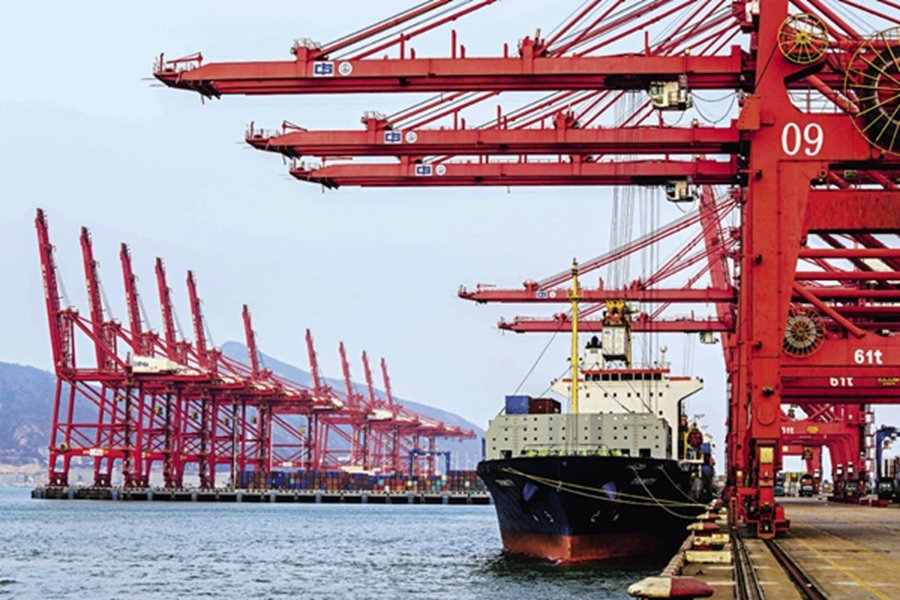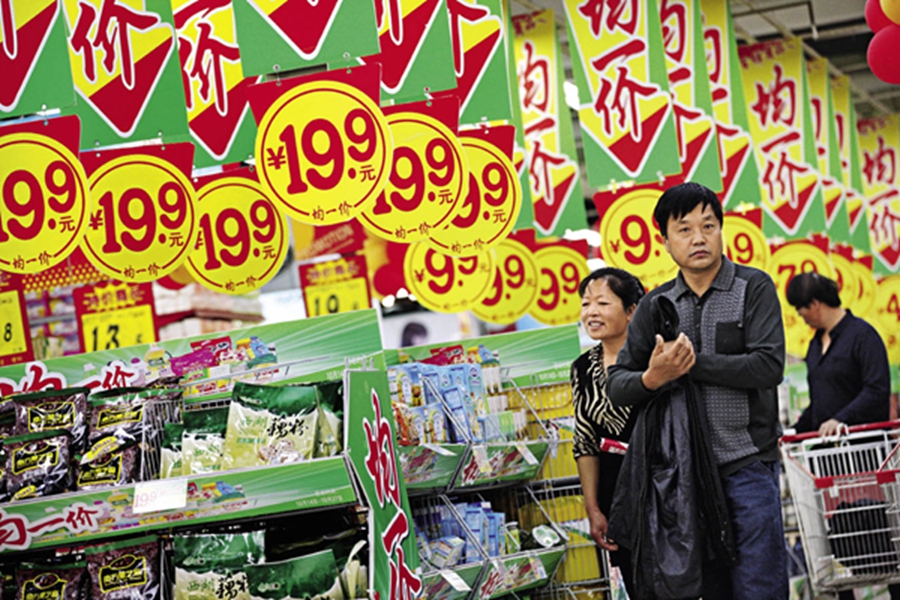By staff reporter JIAO FENG
By staff reporter JIAO FENG
AGAINST the backdrop of an intricate global economic climate, China faces mounting pressure from a downward economy. GDP growth fell to 6.9 percent year-on-year in 2015, a historic low. The beginning of 2016 witnessed lackluster performances in both stock and currency markets, and a breadth of fallen trade even larger than last year, sparking global concern about the state of the Chinese economy.
On March 2, Moody’s adjusted China’s government credit outlook from stable to negative. However, the market responded calmly; the offshore RMB exchange rate was stable and domestic bond and stock markets were unaffected.
The year 2016 marks the initiation of the 13th Five-Year Plan (2016-2020) for Economic and Social Development. A group of distinguished experts and scholars gave their points of view on the questions: In which direction is the Chinese economy headed? Can the macro economy defend the bottomline? And can China overcome difficulties to achieve the five-year plan targets? Their comments are summarized below.

A shipment of imported goods arrives at Lianyungang, a port city in northeastern Jiangsu Province.
Hard Landing?
The year 2016 marks the start of the decisive phase of completing construction of a moderately prosperous society in all respects, and also of a critical stage in advancing structural reform.
On a global scale, uncertainties and unstable factors in China’s external environment affected it to an extent that cannot be underestimated: the world’s economy is undergoing a profound adjustment and a sluggish recovery, with floundering international trade, fluctuations in financial and commodity markets, and elevated geopolitical risks.
From the domestic perspective, accumulative problems and risks have surfaced, apparent in a lower growth rate, the travail of economic restructure, the switch of economic driving forces, and greater downward pressure. Concerns over the Chinese economy are constantly debated. George Soros even predicted China’s inevitable hard landing.
Cao Heping, economist and Peking University professor, holds that China’s national economic system covers a full range of industries. Emerging industries such as those related to the Internet Plus will offset the declining growth rate of trade and investment, and tap into the economy’s great potential.
Xu Shaoshi, chairman of the National Development and Reform Commission, observed that the Chinese economy is flexible and capable of deflecting risks. It has a solid foundation, huge market demands and vast room for development. What’s more, it is improving the quality of production factors, and has garnered rich experience in macro readjustment. “The Chinese economy will definitely not have a ‘hard landing,’” Xu said. “We are capable of operating the economy within a reasonable range.”

A CITIC Heavy Industries workshop in Luoyang, Henan Province.
A Drag on World Economy?
The first quarter of 2016 saw substantial fluctuations in the global financial market and a slump in commodity prices, leaving emerging economies stuck in a rut. Some Western media attributed the world economy’s “bad cold” to China’s “sniffle.”
“This is a false conclusion,” said Liu Shijin, former vice director of the Development Research Center (DRC) of the State Council, a government think tank. “China’s GDP growth rate in 2015 was 6.9 percent, still higher than the world’s average and that of developed economies. It signifies China’s positive role in world economy.”
Zhang Xiaoji, former head of the DRC Foreign Economy Research Department, said that China contributed a share of 25 percent to world economic growth last year, still a high level. He said frankly that the huge investment in infrastructure to jack up commodity prices and spur the world economy that China undertook during the global financial crisis was abnormal and unsustainable, and detrimental to both China and the world in a long run.
Xu Shaoshi remarked that China currently ranks second globally in import volume, and that its demands for crude oil, iron ore, mineral and chemical fertilizer, natural and synthetic rubber, grain, and other products continues to rise. Its contribution to the world economy is indisputable.
Slower Economic Growth a “New Normal”?
The growth rate in 2015 was lower than the expected seven percent, raising questions on whether China had lost its growth momentum.
Economist Li Yining believes that the rate is within a reasonable range. As the economy shifts from industrialization to post-industrialization, the tertiary industry contributes more than half of GDP. From this perspective, the slide in growth is the same as that of other countries around the world.
The economist said that a prosperous second industry made it possible for China to attain rapid development in the past several decades. From the experience of developed countries, in a phase when the tertiary industry dominates, a rate from three to four percent would be no mean feat. “In this period, China should be fully aware of the importance of restructuring and changing the mode of economic development, instead of focusing on growth figures. In other words, restructure is more important than aggregate economic volume.”
“The Chinese economy is entering the ‘new normal’ phase that features lower speed, optimized structure, and switched driving forces. From this angle, China’s economic performance is outstanding,” Xu Shaoshi said. “For example, we created 13.12 million jobs, over 30 percent more than the target. People’s income experienced steady growth, up 7.4 percent. The consumer price index (CPI) went up by a mere 1.4 percent. And the environment has been improved significantly. That’s why I believe the economy is operating within a reasonable range.”

Shoppers at a well-stocked supermarket in Huaibei, Anhui Province.
Difficulties and Challenges
A report from the DRC of the State Council predicts that in 2016 China will see a “dip” in its economy.
Xu Shaoshi said that China would encounter various adverse influences in its economic and social development owing to uncertainties and instabilities in the world economy. Financial market fluctuations, the slump of commodity prices, and geopolitical risks are grim realities. China is faced with three economic tasks at this stage: to simultaneously deal with the slowdown in economic growth, make difficult structural adjustments, and absorb the effects of the previous economic stimulus policies. Meanwhile, China is facing a downward trend in its economy, evident in slower economic growth, lower prices of industrial products, shrinking enterprise earnings in sectors of the real economy, and less fiscal revenue – as well as growing risks in the fiscal and financial sector. In a word, more complexities lie ahead for China’s future development.
Wu Xiaoqiu, director of the Finance and Security Institute at Renmin University of China, said that China was confronted with a three-faceted challenge to its economy. First, dealing with severe overcapacity is still an urgent task. Second, China must change its mode of economic growth and care more about the environment. Third, China should address the widening gap between rich and poor.
Financial commentator Wu Xiaobo said that China faces a bumpy road ahead in 2016. China’s economy is likely to keep falling in the “new normal” period. “Traditional manufacturers are still struggling. Their suffering is far from over. But as we can see, the middle class is emerging and growing, and it contributes to consumption. In both domestic and foreign trade, changes are likely to happen.”
Medium-to-High Growth Possible?
The National Bureau of Statistics released core statistics in January which show that the CPI is rebounding and that the decline in PPI has narrowed on a monthly-and-yearly basis. Trade surplus hit a record high of RMB 406.2 billion and foreign investment is growing fast thanks to the Belt and Road Initiative.
Although growth in 2015 was lower than seven percent, Li Yining believes that the seven percent target is sustainable if structural reform – the key issue – can be implemented. “There’s no denying that China has faced challenges in its economy. Economic downward pressure does exist. Only with reform can China get onto the ‘new normal’ path.” Confidence, as Li said, is vital at the moment.
Clearly, confidence comes from the achievements of the 12th Five-Year Plan period and China’s resolution to deepen all-round reform. At present, the supply-side structural reform – whose emphasis is on cutting overcapacity, destocking, deleveraging, reducing costs, and identifying growth areas – is in operation. With more reform benefits, periodical economic capacities will be strengthened and thus, in the long run, China’s growth potential won’t sharply decrease.
Businesses are most sensitive to the market. Yang Yuanqing, CEO of Lenovo Group, said that companies should be confident about products like smartphones and PCs. While this market seems saturated, product improvement and upgrading can stimulate new demand. In this sense, quality should be improved and high-end and high-value innovative products be produced. In addition, better services offer another opportunity to improve the economy.
Zhang Jindong, chairman of Suning Holdings Group Ltd, said that consumption would lead to future growth. The consumption of high-quality products and big brands will undoubtedly lead the new trend. Zhang said the “new normal” was a period of important strategic opportunities for China. Measures such as promoting new industrialization, reducing the divide between urban and rural areas, increasing public goods supply, and advancing coordinated development across regions will add vitality and impetus to China’s long-term economic development.